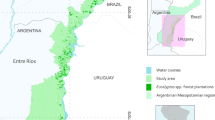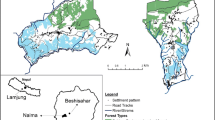Abstract
To implement effective climate change mitigation and carbon sequestration activities in the southern US, nonindustrial private forest landowner (NIPF) participation is necessary because of the significant area of forest land under their ownership. For policy implementation to involve this major ownership group in climate change mitigation activities in this region, it is important to understand their forest management motivations and understanding toward carbon sequestration. This study develops a regional typology of NIPF landowners based on reasons for owning forest land in the southern US. The specific goals were to: (1) segment NIPF landowners into smaller homogeneous groups based on reasons for owning forest land; (2) identify landownership characteristics and forest management behavior by ownership groups; and (3) assess their climate change beliefs and understanding of forest carbon sequestration by ownership groups. A principal component-cluster analysis of 735 responses to a mail questionnaire distributed to NIPF landowners in the southern US revealed three groups, which were named amenity, multi-objective, and timber-oriented landowners. The amenity group included 21% of the landowners, while the timber and multi-objective groups included 40% and 39% of the landowners, respectively. These landowner groups varied in terms of owner characteristics, forest species type and management behavior, climate change beliefs and understanding of carbon sequestration. The amenity and multi-objective owners tend to have more positive belief toward climate change than the timber group, but more landowners in each group indicated having poor understanding of forest carbon sequestration. The study fills a knowledge gap in research efforts by developing a regional typology of NIPF landowners and linking it with their forestry resources and management strategies along with their climate change beliefs and understanding of forest carbon sequestration.
Similar content being viewed by others
Notes
Alabama, Arkansas, East Oklahoma, East Texas, Georgia, Florida, Louisiana, Mississippi, North Carolina, South Carolina, Virginia.
List-Giant http://www.listgiant.com.
References
Adams DM, Alig R, Latta G, White EM (2011) Regional impacts of a program for private forest carbon offset sales. J For 109(8):444–453
Arano K, Munn IA (2006) Evaluating forest management intensity: a comparison among major forest landowner types. For Pol Econ 9(3):237–248
Butler BJ (2005) The timber harvesting behavior of family forest owners. Ph.D. dissertation, Oregon State University, Corvallis
Butler BJ (2008) Family forest owners of the United States, 2006. General technical report NRS-27. US Department of Agriculture, Forest Service, Northern Research Station, Newtown Square
Butler BJ, Leatherberry EC (2006) America’s family forest owners. J For 102(7):4–14
Butler BJ, Wear DN (2013). Forest ownership dynamics of southern forests. The Southern Forest Futures Project. In: Wear DN, Greis JG (eds) USDA Forest Service, Southern Research Station, Asheville
Butler BJ, Miles PD, Hansen MH (2015) National woodland owner survey table web-application version 1.0. www.fia.fs.fed.us/nwos. Accessed 22 Aug 2015
Butler BJ, Hewes JH, Dickinson BJ, Andrejczyk K, Butler SM, Markowski-Lindsay M (2016) Family forest ownerships of the United States, 2013: findings from the USDA forest service’s National Woodland Owner Survey. J For 114:638–647
Coeli H, Stout S (2007) The carbon consequences of thinning techniques: Stand structure makes a difference. J For 105(5):266–270
Conway MC, Amacher GS, Sullivan J, Wear D (2003) Decision nonindustrial forest landowners make: an empirical examination. J For Econ 9(3):181–203
Davis AR, Broussard S (2006) A typology of family forest owners in North Central Indiana. North J App For 24(4):282–289
Dhubhain AN, Cobanova R, Karppinen H, Mizaraita D, Ritter E, Slee E, Wall S (2007) The values and objectives of private forest owners and their influence on forestry behaviour: the implications for entrepreneurship. Small Scale For 6(4):347–357
Dillman DA (2000) Mail and internet surveys: the tailored design method, 2nd edn. Wiley, New York
Finley AO, Kittredge DB (2006) Thoreau, Muir, and Jane Doe: different types of private forest owners need different kinds of forest management. North J AppFor 23(1):27–34
Galik CS, Murray BC, Mercer DE (2013) Where is the Carbon? Carbon sequestration potential from private forest land in the Southern United States. J For 11(1):17–25
Greene JL, Blatner KA (1986) Identifying woodland owner characteristics associated with timber management. For Sci 32(1):135–146
Han XH, Plodinec MJ, Su Y, Monts DL, Li Z (2007) Terrestrial carbon pools in southeast and southcentral United States. Clim Change 84(2):191–202
Johnson DE (1998) Applied multivariate methods for data analysis, 1st edn. Duxbury Press, Pacific Grove
Joshi S, Arano KG (2009) Determinants of private forest management decisions: a study on West Virginia NIPF landowners. For Pol Econ 11(2):118–125
Joshi O, Mehmood SR (2011) Factors affecting nonindustrial private forest landowners’ willingness to supply woody biomass for bioenergy. Biomass Bioenergy 35(1):186–192
Joshi O, Grebner DL, Munn IA, Grado SC, Grala RK, Hussain AR (2014) Factors influencing utilization of woody biomass from wood processing facilities in Mississippi. For Prod J 64:64–71
Kendra A, Hull RB (2005) Motivations and behaviors of new forest owners in Virginia. For Sci 51(2):142–154
Khanal PN, Grebner DL, Munn IA, Grado SC, Grala RK, Henderson JE (2016) Nonindustrial private forest landowner beliefs toward climate change and carbon sequestration in the southern United States. J For 11(4):524–531
Kline JD, Alig RJ, Johnson RL (2000) Fostering the production of nontimber services among forest owners with heterogeneous objectives. For Sci 46(2):302–311
Kluender RA, Walkingstick TL (2000) Rethinking how nonindustrial landowners view their lands. South J App For 24(3):150–158
Kuipers BT, Shivan GC, Witter KP (2013) Identifying appropriate communication means for reaching nontimber private forest landowners. J For 111(1):34–41
Kulluvainen J, Karppinen H, Ovaskainen V (1996) Landowner objectives and nonindustrial private timber supply. For Sci 42(3):301–309
Latta G, Adams DM, Alig AJ, White E (2011) Simulated effects of mandatory versus voluntary participation in private forest carbon offset markets in the United States. J For Econ 17(2):127–141
Majumdar I, Teeter L, Butler B (2008) Characterizing family forest owners: a cluster analysis approach. For Sci 54(2):176–184
Malmsheimer RW, Heffernan P, Brink S, Crandall D, Deneke R, Galik C, Gee E, Helms JA, McClure N, Mortimer M, Ruddell S, Smith M, Stewart J (2008) Forest management solutions for climate change. J For 106(3):115–171
Murray BC, Sohngen BL, Sommer AJ, Depro BM, Jones KM, McCarl BM, Gillig D, DeAngelo B, Andrasko K (2005) Greenhouse gas mitigation: potential in US forestry and agriculture. US Environmental Protection Agency, Office of Atmospheric Programs. EPA-R-05-00
Nyland RD (2001) Silviculture: concepts and applications, 2nd edn. McGraw Hill, Boston
Olenick KL, Kreuter UP, Conner JR (2005) Texas landowner perceptions regarding ecosystem services and cost-sharing land management programs. Ecol Econ 53(2):247–260
Raunikar R, Buongiorno J (2006) Willingness to pay for forest amenities: the case of nonindustrial owners in the south central US. Ecol Econ 56(1):132–143
Salmon O, Brunson M, Kuhns M (2006) Benefit-based audience segmentation: a tool for identifying nonindustrial private forest owner education needs. J For 104(8):419–425
SAS Institute Inc (2008) SAS/STAT 9.2 user’s guide. SAS Institute Inc, Cary
Thompson DW, Hansen EN (2012) Factors affecting the attitudes of nonindustrial private forest landowners regarding carbon sequestration and trading. J For 110(3):129–137
Thompson DW, Hansen EN (2013) Carbon storage on nonindustrial private forestland: an application of the theory of planned behavior. Small Scale For 12(4):631–657
US Environmental Protection Agency (2013) Inventory of US greenhouse gas emissions and sinks: 1990–2011. US Environmental Protection Agency, Office of Atmospheric Programs. EPA #430-R-13-001
Vokoun M, Amacher GS, Wear DN (2006) Scale of harvesting by non-industrial private forest landowners. J For Econ 11(4):223–244
Wear DN, Greis JN (2013) The southern forest futures project: technical report. USDA, Forest Service. GTR SRS-178. Asheville
Acknowledgements
Funding was provided by PINEMAP, USDA National Institute of Food and Agriculture (Grant No. #2011-68002-30185).
Author information
Authors and Affiliations
Corresponding author
Rights and permissions
About this article
Cite this article
Khanal, P.N., Grebner, D.L., Munn, I.A. et al. Typology of Nonindustrial Private Forest Landowners and Forestry Behavior: Implications for Forest Carbon Sequestration in the Southern US. Small-scale Forestry 16, 419–434 (2017). https://doi.org/10.1007/s11842-017-9363-4
Accepted:
Published:
Issue Date:
DOI: https://doi.org/10.1007/s11842-017-9363-4




